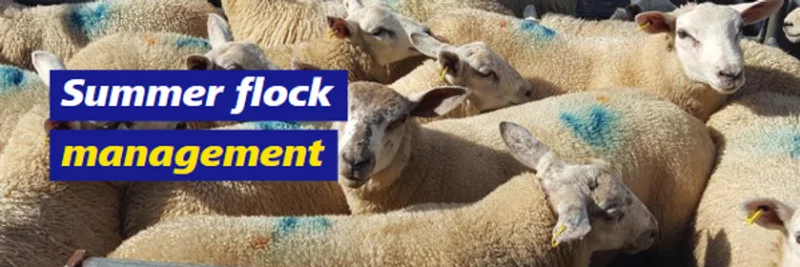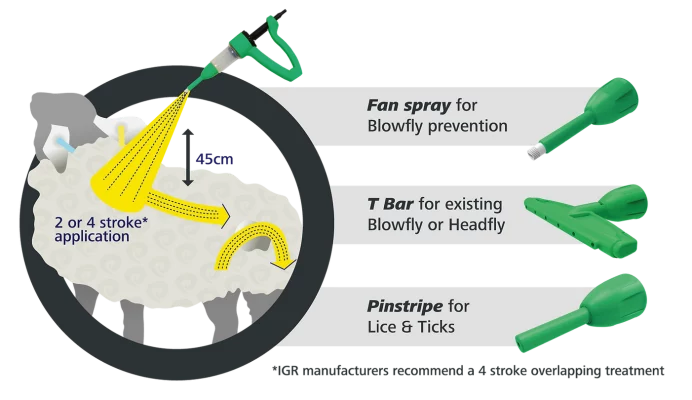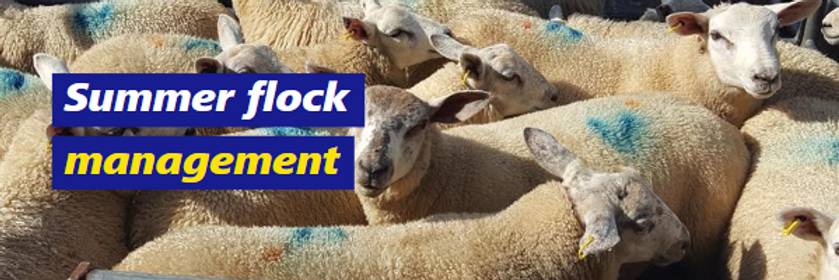Tags
Summer Flock Management

With around 85% of the finished lamb market requiring E, U and R grades for conformation and 2 and 3L for fat class, prime lamb production is reliant on nutritional needs as well as good health and welfare to deliver and receive a premium from the market. Yet with around 40% of Prime lambs not hitting the preferred market criteria, there are improvements still to be made in the UK flock.
Fly strike is encountered in 8/10 flocks or up to ½ million sheep so prevention is key. The severity of fly strike can very much be weather-related and as such, hugely variable year by year. Not treating promptly can lead to severely reduced performance, secondary infections or death. Leaving animals untreated when knowingly affected with strike is also a serious welfare issue. Studies have shown that lambs with scour are 8.5 times more likely to be affected. Open wounds can be reduced by avoiding ear tagging lambs during high risk periods also.
SCOPS Preventative steps
-
Have a sound worm control strategy to avoid scouring and poor health arising
-
Dagging to reduce soiling and/or remove dirty wool around the breech
-
Reduce the incidence of soiling and avoid nutritional upsets causing scouring
-
Tail sheep and avoid breeding from sheep that are habitually struck and/or tend to soil themselves due to their conformation
-
Dispose of any dead animals quickly
-
Reduce and address footrot incidence as a flystrike target as well as head and body strike
Blowfly strike can be prevented through the application of an appropriate product before a period of challenge and strike is usually caused by the greenbottle fly with females attracted by the odour of decomposing matter such as wounds, soiled fleece or dead animals. Blowfly attacks usually occur in waves and the odour from this first strike attracts other flies. When the populations of larvae become overcrowded they will attack the living tissue of the sheep with agitation and discoloured wool being the first signs.
Maggots feed voraciously and toxins released by damaged tissues and ammonia secreted by the maggots are absorbed through the lesions into the sheep’s bloodstream, causing illness and death in severe cases. Secondary bacterial infections are also common and death can occur.
Body strike is not the only risk, with flystrike of foot lesions causing severe non-weight bearing lameness, making the existing animal condition far worse.
The period of risk expected between May and September has now been observed in lowland areas between March and December in the UK.
Not everyone is set up for plunge dipping which offers good preventative coverage for flies and other ectoparasites such as scab, lice, ticks, keds and headfly. Pour-on applied individually in seconds provides fast cover and generally lower withdrawal periods allowing finished lambs to go when ready to meet market requirements.
Insect growth regulator (IGR)
-
Flies lay eggs but larvae do not fully develop and prevent strike attack
-
Some formulations spread and binding to the fleece if applied correctly
-
Up to 19 weeks protection after shearing but higher cost
-
Other ectoparasites not treated
Synthetic pyrethroids (SPs)
-
Insecticidal and kill adult and larval stages on contact
-
Treats other ectoparasites
-
A shorter coverage, withdrawal period and lower cost
-
Suitable in protecting new season lambs before they finish
Plunge dip
-
Excellent coverage and control of many ectoparasites
-
Fixed or mobile facilities required
-
Certificates of competency and disposal permits required
-
Sheep must remain immersed for one minute or effectiveness against fly strike can be reduced
-
Sheep can require at least 3 weeks fleece growth for the insecticide to bind
-
Dips are harmful to humans so extreme care and PPE required
-
Longer withdrawal periods typically
Handling and application
Make sure the handling system is adequate, so application can be applied correctly and sheep are not overcrowded. do not apply to a dirty fleece or treat in the rain, protect yourself with PPE and invest in a decent device with the correct nozzle as they all perform a different job.

Fan or Rose sprays deliver both IGR and insecticidal SP treatment groups applying onto the back and hindquarters. Application technique can be very different for the fleece binding or contact nature of both actives to work correctly. Read the instructions carefully.
T-bars provide treatment for actual blowfly strike and Headfly control using insecticidal SP treatments and not recommended for use with preventative IGR. For active strike, treat all affected areas, or maggots may survive.
Pin-strip (straight) nozzle are used for both tick and lice control. With ticks, apply as a pin-stream from the crown of the head to the top of the rump. Whereas with lice, start at the shoulders then to the rump again, along the middle of the back.
Personal protective equipment (PPE)
Wearing appropriate PPE during the application of pesticides has reduced dermal exposure to pesticides such as cypermethrin which has been observed as the primary route of exposure during treatment. PPE should therefore be worn at all times; eye protection, face mask, protective clothing, rubber gloves and boots when applying the product. Consider Using a face mask if applying as a fan spray. Specific instructions should be carefully read and carefully adhered to before treatment commences.
Ensure that PPE equipment chosen conforms with any recommendations made of the product chosen. Make sure PPE fits properly and staff understand how to use it.
Washing of any splashes from skin should be undertaken immediately with clean water. If product splashes in eyes, flush thoroughly with water for a prolonged period and seek medical advice immediately. Also use in a well-ventilated area and avoid inhaling the vapour.
Equipment checklist
-
Use the correct dosage to the size of the heaviest animal, not the average
-
Match the applicator to the quantity of treatment required
-
Weigh and consider splitting mixed size batches to prevent underdosing
-
Check that the weigh-crate is accurate and clean underneath
-
Consider an upgrade to a digital weighing system
-
Check the correct treatment is being delivered even with selectable/dial a dose devices
-
Use a calibration tube, the neck of a 10ml syringe or a container with accurate calibration marks
-
Squirt three or four doses and check the level each time and look out for air bubbles
-
Place a gloved finger over the nozzle squeeze to ensure internals are not leaking product back inside the pack
-
Resistance to product draw up, dried residual product and worn springs or washers all affect accuracy
-
Fit springs at both tube ends avoiding kinks that restrict flow and draw air
-
Ensure a clean and free barrel movement, re-lubricate with vegetable (NOT mineral) oil on the plunger O-ring or replace the applicator
Animal Health Delivery Systems from Simcro and NJ Phillips for pour-on, oral or injectable applications provide upmost accuracy and efficacy. Livestock Performance solutions from Tru-Test include EID Stick and Panel Readers allowing treatment date to easily be recorded. Weigh scale indicators and Load bars make weighing quick easy and accurate. Livestock Identification Systems include EID tagging solutions including Z for cattle or sheep, TagFaster, and Rubba for treatment record keeping compliance and good management purposes.


